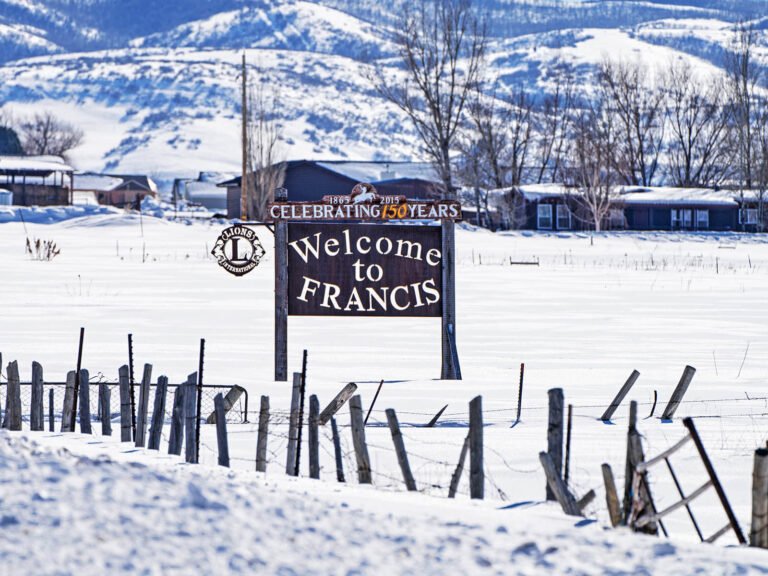Meet a developer with a love for Hart Crossing.
There aren’t any developers as attached to Kamas Valley as Rusty Webster. He’s a fourth-generation family man with a vision for the valley — one that focuses on preservation in the face of growth.
“Everything is changing as Park City is filling up, and Kamas Valley is changing along with it,” says Rusty. “If we develop neighborhoods that retain the rural atmosphere of Kamas Valley, we’ll preserve the countryside that my family fell in love with closing in on a century ago.”
When Rusty’s grandfather, Clark Webster, arrived in the 1960s, he immediately fell in love with the astonishing beauty of the area. Kamas Valley is framed by the high, rounded peaks of the Uintas to the east and the rough crags of the Wasatch Mountains to the west. The land was rich with wildlife and majestic forests — best known as the gateway to Zion for the first pioneers who followed the first natural corridor down Echo Canyon and walked along the banks of the Weber River before cutting a path across the mountains toward the Great Salt Lake.
The area was in the midst of a transition at the time. The rise and fall of mining towns had left only a few farming families willing to face the challenge of high altitude farming and the development of super highways and reservoirs that are now considered essential assets to the community.
“My grandfather had an entrepreneurial spirit and founded Webster Builders, which was mostly responsible for minor excavations before the family business got heavy into underground work,” says Rusty. “As the business grew, we were contracted to do groundwork for subdivisions, commercial buildings, warehouses, recreation centers — you name it. And then, as the business passed from one Webster to the next, we diversified to building vertical too.”
Rusty remembers it all because he grew up right along with the company, taking over operations when he was only 19 years old, after learning how to lay pipe, pour concrete, and frame. Aside from commercial work, the company was building only five or six 1,500- to 1,800-square-foot homes a year.
“Working side by side with my grandpa and dad, we did everything together, one home at a time,” says Rusty. “They taught me how much reputation means in a small community, how to find the best local subcontractors to get some jobs done, and how to build quality homes the right way in Kamas Valley. Having hands-on experience certainly helps. If somebody says they can’t do something, I’ll roll up my sleeves and be the first to show them how to do it or find a new solution.”
Often, Rusty adds, it comes down to understanding Kamas Valley. For instance, Kamas Valley homes should be built to withstand a 90-pound snow load instead of a 40-pound snow load. They should be fitted with R44 insulation instead of R22. They should be made with 2×6 walls instead of 2×4, allowing for an extra inch of insulation and 2 inches from the inside edge of the window.
“Some builders offer energy efficiencies as upgrades. We consider them standard,” says Rusty. “I never understood it, and neither did my dad. Why build your neighbor a custom home they can’t afford to heat in the winter? You don’t make many friends that way.”
To put it succinctly, Rusty says Webster Construction doesn’t build homes to code; they build them to function. He tells everyone from the architect to the sales team to treat every home like the home they’re building for their own family.
“Don’t call me to ask if you can add an extra outlet where it’s needed,” muses Rusty. “If your home would need it, add it. I suppose that’s what makes Hart Crossing so special too. We’re making custom homes accessible to more people by building a semi-custom community. Top to bottom, start to finish — it’s the same team — and all of us are local. Heck, we even try to use the local sawmill when we buy lumber.”
Webster Construction is deeply involved in the community too. They actively support the local high school rodeo team and National High School Rodeo Association. The family, like many families in Kamas Valley, also enjoys the cowboy lifestyle that attracted post-mining settlers to the area more than a hundred years ago.
“Sometimes people get sore at the development of Kamas Valley,” says Rusty. “I get it. Me too. But I also figure the best way to preserve Kamas Valley is to manage the development instead of letting outside development manage us.”
Allowing for some subdivisions like Hart Crossing is one solution. Offering a mix of lots with multiple price points inside a master-planned community with 50 percent of the land reserved as open space (or more) preserves the rural atmosphere. It also ensures future conservation, much like how the cherished reservoirs around Kamas Valley did some decades ago.



